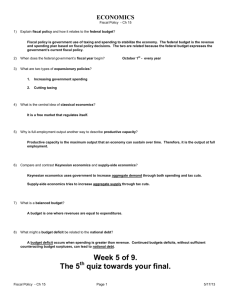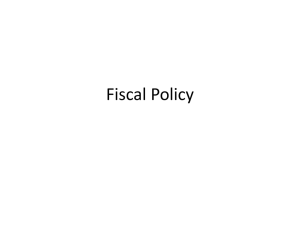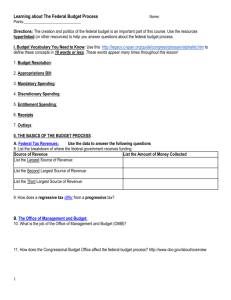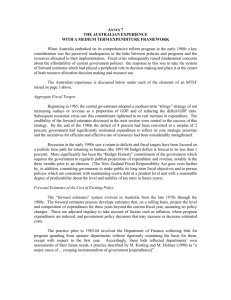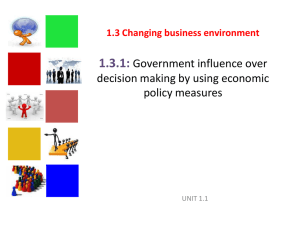Unit 4
advertisement
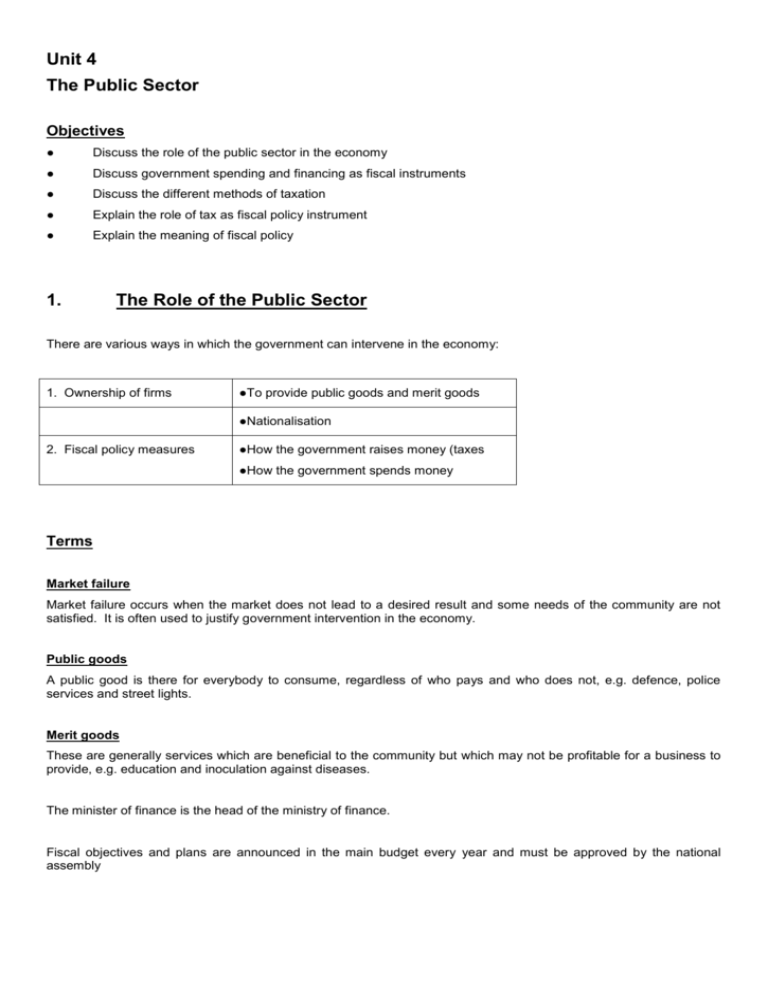
Unit 4 The Public Sector Objectives ● Discuss the role of the public sector in the economy ● Discuss government spending and financing as fiscal instruments ● Discuss the different methods of taxation ● Explain the role of tax as fiscal policy instrument ● Explain the meaning of fiscal policy 1. The Role of the Public Sector There are various ways in which the government can intervene in the economy: 1. Ownership of firms ●To provide public goods and merit goods ●Nationalisation 2. Fiscal policy measures ●How the government raises money (taxes ●How the government spends money Terms Market failure Market failure occurs when the market does not lead to a desired result and some needs of the community are not satisfied. It is often used to justify government intervention in the economy. Public goods A public good is there for everybody to consume, regardless of who pays and who does not, e.g. defence, police services and street lights. Merit goods These are generally services which are beneficial to the community but which may not be profitable for a business to provide, e.g. education and inoculation against diseases. The minister of finance is the head of the ministry of finance. Fiscal objectives and plans are announced in the main budget every year and must be approved by the national assembly The functions of government Establishing a stable and safe environment The first duty of government is to provide: ● a safe environment in which society can function e.g. all the institutions and infrastructure we need to perform economic activities and the laws and regulations required for carrying out these activities in an orderly manner. ● courts of law and law enforcement officers ● protect the country against foreign aggression. Combating externalities Externalities can be defined as costs or benefits that are borne or enjoyed by parties not directly involved in an activity. They are also called spill over effects. Where there are external costs, we refer to negative externalities e.g. pollution or noise. Governments have the responsibility to correct these negative externalities through legislation or taxes. External benefits are called positive externalities e.g. the immunisation of babies against infectious diseases and the aids awareness campaign. Promoting competition Government should ensure that markets are as competitive as possible. A free market could lead to the formation of monopolies that may operate against public interest. The government can provide legislation that regulates the formation of monopolies. Promoting economic growth The government can use expansionary fiscal policy measures such as increased spending when the economic performance is poor. Restrictive measures such as reduced government spending or increased taxation can be used to cool down the economy in inflationary conditions. Social welfare Government can provide basic social welfare programmes such as old age and disability pensions, basic education and unemployment insurance. Support the market mechanism The government should support the market mechanism by providing public goods and merit goods. A fair distribution of resources The government should take measures to provide a fair distribution of income: ● Revenue side of the budget: this can be achieved through a progressive income tax system. ● Expenditure side of the budget: retirement pensions, sickness benefits, unemployment benefits, free primary health care, free primary education or low cost housing. 2. Government Expenditure Government spending is one of the legs of fiscal policy. It has the following objectives ● To render essential services ● To be used as fiscal policy instrument There are five expenditure categories in the Namibian Budget: ● Expenditure by vote: These are funds allocated to the different government ministries. ● Current expenditure: All personnel expenditures and the purchases of goods and services. ● Capital expenditure: Vehicle purchases and construction activities such as building roads, dams, schools, etc. ● Statutory expenditure: To pay interest on loans. ● Development budget: This is the budget of the National Planning Commission where money is allocated to development projects outlined in the National Development Plan. 3 Government Revenue Government derives income in two main ways, namely, from taxes and from loans. Taxation Definition: Taxation can be defined as the compulsory transfer of money from individuals or institutions to government. Objectives of taxation: ● To finance government expenditure ● To be used as fiscal policy instrument ● To redistribute income Types of taxation Direct taxes: Direct taxes are levied on the income and wealth of persons or organisations such as companies. personal income tax, company tax and estate duty. These taxes cannot be shifted. Examples: Indirect taxes: Indirect taxes are levied on economic transactions and are paid by those who consume the goods and services. Examples: value added tax (VAT), excise duties (sin taxes) and customs duties (tariffs). These taxes can be shifted. Tax shifting: Tax shifting means to pass the tax burden from one taxpayer to another. Methods of taxation According to the method of calculation, a tax can be progressive, proportional or regressive. The distinction between these methods is based on the percentage of our income that we pay. Progressive taxation Taxes are progressive if they take a larger percentage of income as income rises, e.g. personal income tax is an example of a progressive tax. Table 1 shows a simplified example of a progressive tax. Table 1: Progressive taxation Income Tax paid Percentage of income N$30 000 N$4 500 15% (4 500/30 000 x 100) N$40 000 N$8 000 20% (8 000/40 000 x 100) Progressive taxation can cause a phenomenon that is known as fiscal drag. We often receive salary increases to keep up with inflation and to keep our purchasing power the same. The salary increases put us in higher tax categories and that means we pay a larger percentage of income in tax. We therefore have very little advantage from the salary increase. Proportional taxation Taxes are proportional if taxpayers pay a fixed percentage of their income regardless of the level of income, for instance 10% of income. In other words, the tax rate is the same for all taxpayers. Example: company tax. Table 2 shows a simplified example of a proportional tax. Table 2: Proportional taxation Taxpayer Income Tax paid Percentage of income Mr A N$ 50 000 N$ 5 000 10% (5 000/50 000 x 100) Mr. B N$100 000 N$10 000 10% (10 000/100 000 x 100) Regressive taxation Taxes are regressive if they take a larger percentage of income as income falls and a lower percentage of income in taxes as income rises. In other words, a regressive tax takes a larger percentage of the income of low-income individuals than those with higher incomes. VAT is an example of a regressive tax. Suppose Mr A earned N$50 000 and Mr B earned N$100 000. Both of them bought goods for N$20 000 on which 15% VAT is levied. They would pay the following percentages of their income in tax: Table 3: Regressive taxation Taxpayer Tax paid Percentage of income Mr A 15% of N$20 000 = N$3 000 N$3 000 of N$50 000 = 6% Mr B 15% of N$20 000 = N$3 000 N$3 000 of N$100 000 = 3% Activity 1 The table below shows the amount of tax paid by individuals in three different income categories. For each of the three taxes, indicate whether the tax is progressive, proportional or regressive. Income % of income Income N$40 000 N$20 000 % of income Income N$60 000 Tax A N$2 000 N$4 000 N$6 000 Tax B N$1 400 N$2 600 N$3 600 Tax C N$1 200 N$3 000 N$5 600 Tax A is: Tax B is: Tax C is: % of income Loans If the government spends more than its revenue from taxes, there is a deficit budget. To take care of the excess spending, the government must borrow money. These loans can be obtained from the private sector or from abroad. Loans from the private sector ● Treasury bills: Treasury bills are short-term securities maturing after 3 months, 6 months or 12 months. ● Government bonds: Government bonds are long-term securities that are traded on the Namibian Stock Exchange. They are identified as GC 15, GC24, etc. Loans from abroad The government can also borrow from foreign banks, governments, the World Bank or the International Monetary Fund (IMF). The World Bank gives loans for development projects such as roads and dams. The IMF gives loans to countries with debt problems. Interest has to be paid on all these loans. As a fiscal policy instrument loans can be used to stimulate the economy and to develop the country. Criteria for a good tax Any tax should meet the following requirements: Simplicity A tax should be simple enough for the taxpayer to understand how much, where, when and how to pay. Neutrality Taxes should not discriminate between taxpayers by levying an extra tax on certain goods. However, excise taxes discriminate against smokers because smoking is considered to be an undesirable and luxury habit. Fairness The tax burden should be spread as fairly as possible among the various taxpayers. The following two principles apply: ● The benefit principle: Consumers should pay for the services they receive from government, for instance toll on roads, taxes included in the price of petrol and airport taxes. ● The ability-to-pay principle: the greater a person’s income and ability to pay, the more tax should be paid, for instance progressive income tax. Terms: Tax avoidance Tax avoidance is legal and involves the exploitation of tax loopholes to pay as little tax as possible. Funds can be applied where they will attract the least tax, or all allowable expenses can be deducted. Tax evasion Tax evasion occurs when people do not pay the taxes they are supposed to pay. For instance, they may not declare taxable income or they may deduct expenses they did not actually have. Tax evasion is illegal. Effect of a tax Taxes increase the prices of goods resulting in a decrease in the quantity purchased of the good. 4. The Budget The budget is a statement showing the government’s planned expenditures and estimated revenues for some period, usually one year. Fiscal policy changes are also announced in the budget. Deficit budget: Government expenditure is greater than the revenue from taxes. The deficit must be financed by loans, for instance the issuing of treasury bills and government bonds. Surplus budget: The revenue from taxes is greater than the government expenditure. Balanced budget: The revenue from taxes is equal to government expenditure. 5. Fiscal Policy Definition: Fiscal policy can be defined as deliberate changes in government expenditures and/or taxes to promote particular macroeconomic goals such as full employment, stable prices and economic growth. The aim of fiscal policy is to influence the national income by changing the total demand for goods and services. Total demand consists of consumer expenditure, investment expenditure, government expenditure and net exports (Y = C+I+G+X-M). Instruments of fiscal policy: ● Government expenditure ● Taxes Fiscal policy can be expansionary or restrictive (contractionary). Expansionary fiscal policy Expansionary fiscal policy increases production, employment and income and can be used to move the economy out of a slump or recession or it can be used when unemployment is high. Decrease taxes (T) A decrease in tax rates will increase consumption (C) because consumers will have more money to spend. Businesses will have a larger part of their profits to spend on capital goods and investment (I) will increase. If consumption (C) and investment (I) increase, aggregate demand will increase. Increase government spending (G) The second option is to increase government spending (G). This will increase aggregate demand. Restrictive (contractionary) fiscal policy A restrictive fiscal policy decreases production, employment and income. It can be used to combat the problem of inflation. Increase taxes Higher tax rates will decrease the disposable income of consumers and thus decrease consumption (C). Businesses will pay a larger percentage of their profits as tax and will have less money for investment (I). Aggregate demand will decrease. Decrease government spending A reduction in government expenditure (G) will also decrease aggregate demand. You should note, however, that it is very difficult, perhaps impossible, for governments to decrease their expenditure Activity 2 State whether fiscal policy is restrictive or expansionary in each of the following cases and how it will affect aggregate demand: 1. Personal income taxes are increased by 5% across the board. 2. The government increases its expenditures on highways and bridges by N$10 billion. 3. The government decreases tax rates for corporations. 4. The government increases funding for unemployment insurance. 5. Due to increased expenditures, the government’s budget shows a deficit. 6. The government slashes national defence expenditures as peace spreads throughout Africa. 7. Expenditures on the food-stamp programme are increased by 15% to help the poor. Activity 3 1. If the government decides today that aggregate demand is deficient and is causing a recession, what is it likely to do? 2. If the government decides today that aggregate demand is excessive and is causing inflation, what is it likely to do? Automatic stabilisers The Minister of Finance cannot make decisions about everything in the economy and, therefore, certain measures are built into the system that will not require decisions. Automatic stabilisers consist of changes in government spending and taxes that occur automatically as the conditions in the economy change. The most important stabiliser is our progressive income tax system. Income tax adjusts automatically to changes in personal income. If you earn more income, you pay more tax. Unemployment insurance also serves as an automatic stabiliser. During times of economic growth when people have jobs, money is paid into the system. During times of high unemployment, government will start making payments to persons who lost their jobs. These payments will increase income and expenditure. Shortcomings of fiscal policy 1. Timing lags Three timing lags restrict the application of fiscal policy. A lag means a delay. ● Recognition lag: It refers to the time between the beginning of a recession or inflation and the recognition that it is actually occurring. It may take up to three months before policy makers are sure that the problem is more than just a disturbance. ● Administrative lag: The way governments operate make quick action impossible. Fiscal policy changes need approval by the national assembly before it can be implemented and the process can take months. ● Operational lag: This refers to the time it takes before the decision can be implemented. Changes in tax rates can be implemented quickly, but increased spending on capital projects takes a long time. 2. Irreversibility It is difficult to reverse changes in tax rates. Once a tax is increased, the government is often reluctant to reduce that tax as it provides additional revenue. Increased government spending is also difficult to reduce. 3. Inflationary bias Politicians tend to favour expansionary policies over restrictive policies. Because we elect politicians, they are not keen to approve unpopular policies because they may not be re-elected. Restrictive policies such as higher taxes are unpopular among voters. 4. Crowding–out effect Crowding-out occurs when government spending exceeds revenue from taxes, resulting in a budget deficit. With crowding out, consumption and investment decrease as a result of increased government spending. The process is simplified and mapped out in the diagram below. The crowding-out effect Government spending exceeds revenue from taxes, resulting in a budget deficit. The government enters the loanable funds market and issues more securities. As the demand for loanable funds rises, interest rates increase. Firms and households buy fewer machines, equipment, cars and houses. Thus government spending crowds out private sector spending.




